Migration Madness on the Yorkshire Coast
Luckily for me, I spent almost all of October birding here on the Yorkshire coast - lots of it here in Filey, some of it at Flamborough (mostly guiding for YCN), and some of it at Spurn (also guiding for YCN) - and it was great. I may be biased, and also influenced by the fact I had pretty much the whole month in the field, gratefully lapping up whatever migration was occurring, but it was especially good - rich and varied throughout, with several massive falls and lots of action generally (and a whole host of rarities and scarcities).
Snow Bunting, Carr Naze © Mark Pearson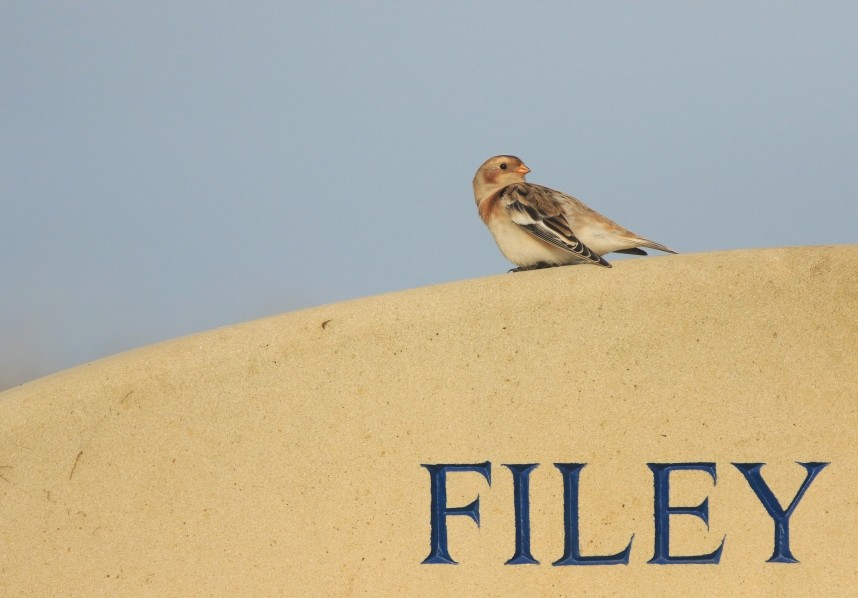
Buckle up, kick back, and join me for a blow-by-blow account of a month to remember, where coastal birding hardly gets any better!
Jack Snipe in off at Carr Naze © Mark Pearson 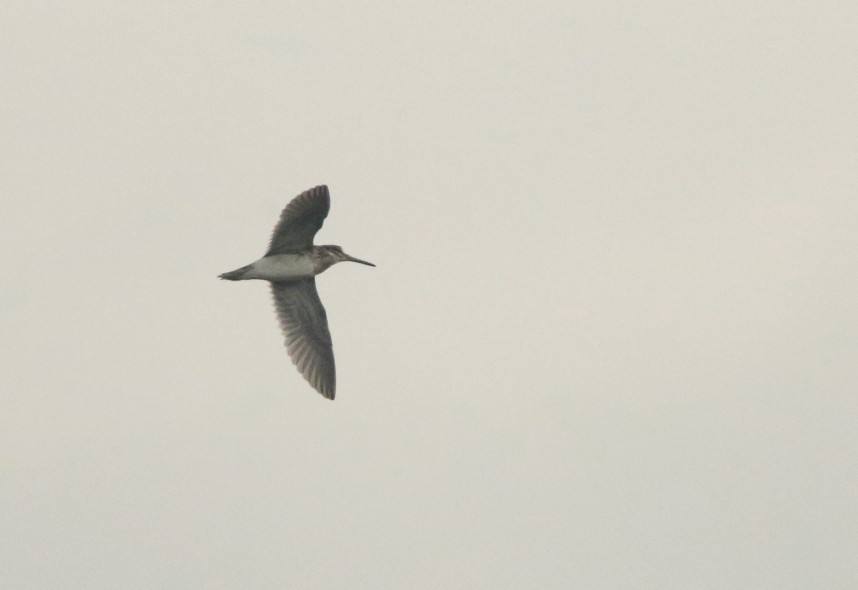
1st - 6th
It started reasonably calmly, although birds finally began to arrive (both in off and during vismig sessions) as the south-westerlies eventually, erratically started to abate. Pink-feet were a constant feature, as were good numbers of finches, an increase in e.g. Goldcrests and Chiffchaffs, and a few thrushes, including a Ring Ouzel and an overdue first Redwing on 2nd.
Freshly arrived Goldcrest on the clifftop © Mark Pearson 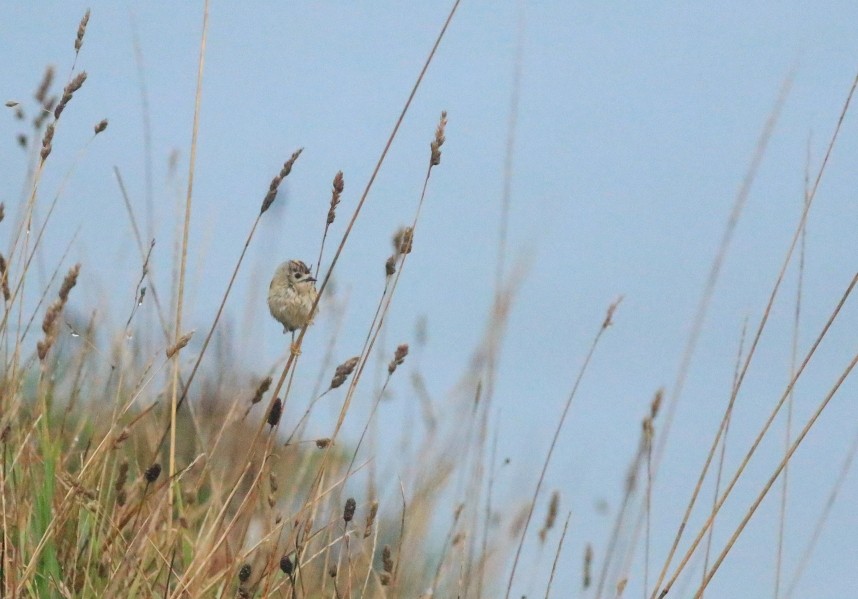
7th & 8th
The forecast looked increasingly promising, and by the beginning of the second week, it was game on - despite strong offshore winds here on the coast overnight on 6th/7th, high pressure, lowering temperatures and ideal migrating conditions (after weeks of blocking systems) had facilitated a mass exodus of birds from across Scandinavia and Northern Europe (and beyond), and they were on their way....
Thrushes arriving en masse at Carr Naze © Mark Pearson 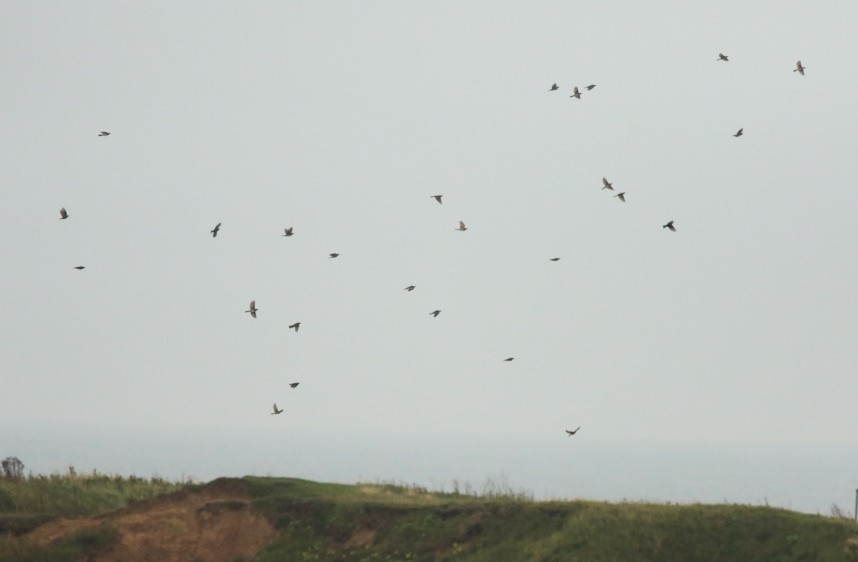
A frustratingly timed, energy-sapping bout of Covid dictated that slow patrols of the coastal strip - particularly Carr Naze and North Cliff - with similarly slow forays into areas of cover were the order of the days, but as it turned out, pretty much all the action was centred on multitudes of birds arriving in-off and over/into these areas, and I was fortunate to be in pole position throughout.
With a strong south-westerly blowing, my first session here at Filey on the morning of 7th was thus actually pretty quiet, the highlight being a near-breeding plumage Black-throated Diver among many Red-throats, a bit of wildfowl passage and single Wheatear and Redwing on Carr Naze; an almost five hour session in the afternoon, however, was far more like it, and despite the blustery offshore winds, birds were powering through regardless.
Whooper Swans arriving over stormy seas. © Mark Pearson 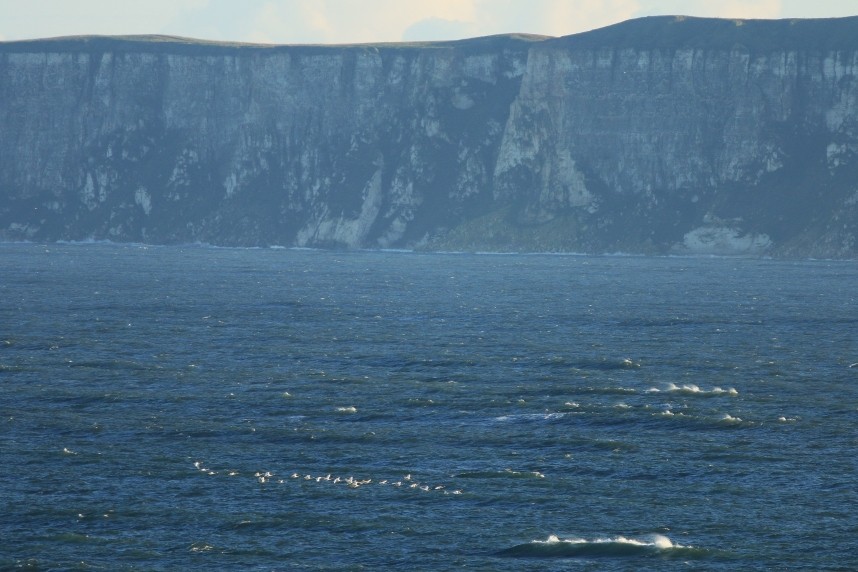
The first push of thrushes - mostly Redwings (1,435) - plus three Jack Snipe, three Short-eared Owls, four Common Snipe, 20+ each of Siskin and Redpoll, Snow and Reed Buntings and more in off, and an increase in migrants (especially Chiffchaffs and Robins) in nearby cover, made for an entertaining session, and the first real arrival of the autumn - with the feeling that much more was on the way....
An exhausted Siskin on the cliff side © Mark Pearson 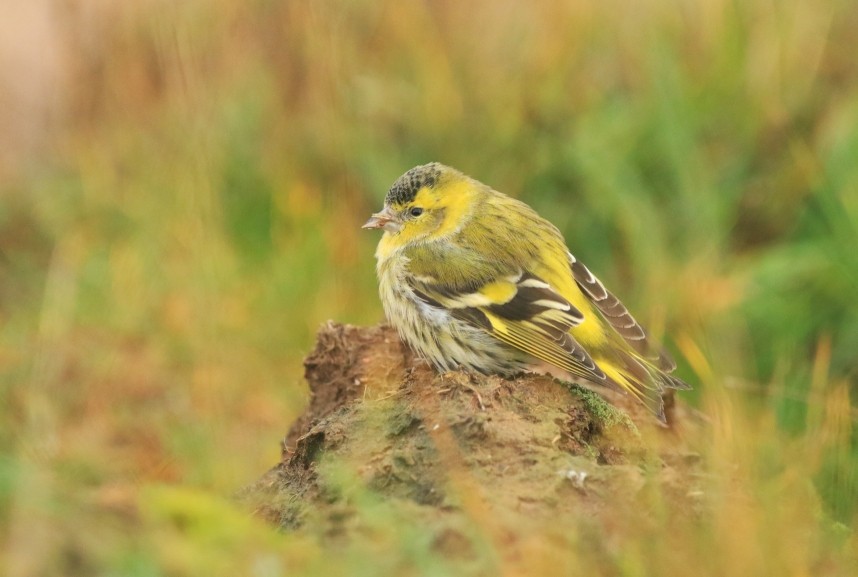
...which there surely was - but why wait til daytime...? A massive, record-breaking nocturnal arrival of thrushes commenced at around 0240hrs, and continued relentlessly until dawn, and thankfully (despite extreme grogginess) I'd remembered to set the MP3 recorder rolling from the study window. For full details of that extraordinary night's nocmig, see here.
Here comes the flood.... Redwings, Blackbirds and Song Thrushes arriving over Filey town in the early hours of 8th October © Mark Pearson 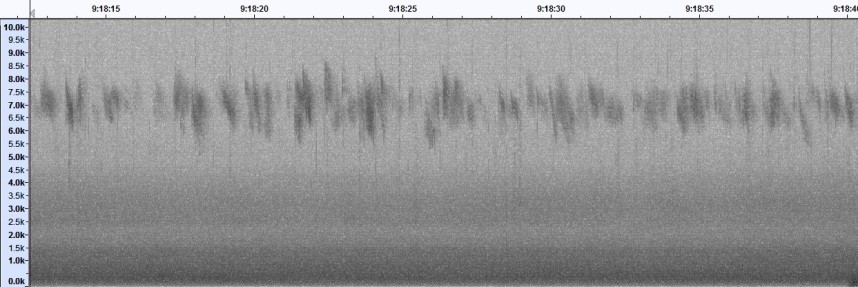
Simultaneously full of Covid and toddler-on-Christmas-Eve excitement, I resolved to spend all day in the field on 8th, and began with a near six-hour session in the northern coastal area - almost of it enjoying slow patrols of Carr Naze (but also a check of nearby North Cliff and Top Scrub). Birds were arriving constantly from (before) first light, with personal totals of 64 Bramblings, 2435 Redwings, three Short-eared Owls, 120 Song Thrushes, 60 Goldcrests, 24 Dunnocks, 50 Robins, Jack Snipe and three Ring Ouzels, plus a variety of other species in arriving in smaller numbers (Stonechats, Wheatears, Siskins, Snow and Reed Buntings, Chaffinches, Skylarks, Chiffchaffs and many more). A thrill....
One of three Yellow-browed Warblers to arrive in Gristhorpe Bay hedge, early afternoon of the 8th © Mark Pearson 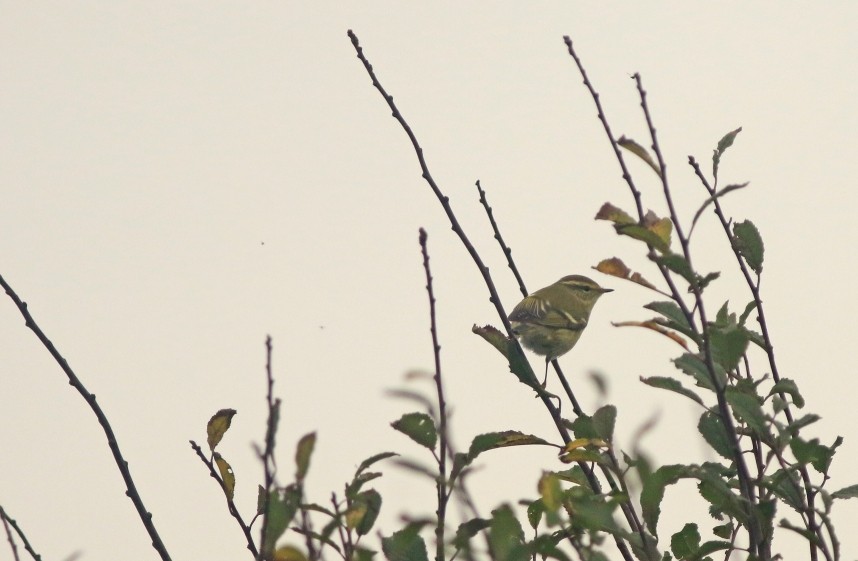
Birds were on the move over the sea, too, with 335 Wigeon, 45 dark-bellied Brent Geese, Goosander, Red-breasted Merganser, Pintails, Common Scoters, Curlews, 12 Grey Plovers, a late-ish Whimbrel, Arctic Skuas, Common and Sandwich Terns, Shovelers and Pink-footed Geese; plenty to enjoy in all directions....
Great Northern Diver heading into the bay © Mark Pearson 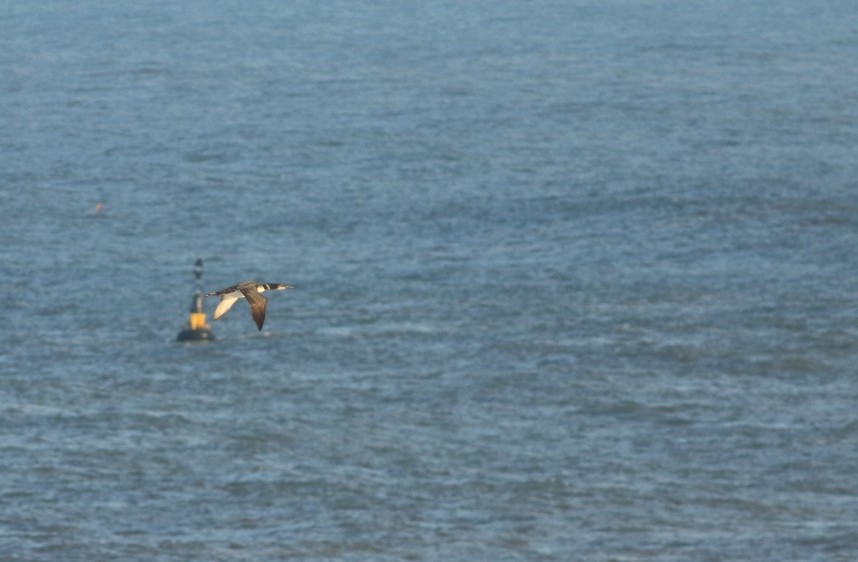
.... but after a quick lunch, a change of scene to nearby Gristhorpe Bay, a small area of coastal scrub and hedgerow a little way up the coast. After ruminating on the lack of Yellow-browed Warblers thus far, I was treated to no fewer than three, contacting calling and loosely associating with other, clearly (very) fresh-in and flitting around the clifftop hedgerow. What a joy.
Another round of the northern coastal area was again productive and full of birds, but the light was seriously starting to fade (and my energy levels with it), and realistically it was a last roll of the die; and so to Arndale, the wooded ravine leading down to the beach, where I've had plenty of luck finding quality birds over the last decade or so.
Short-eared Owl arriving in off at Carr Naze © Mark Pearson 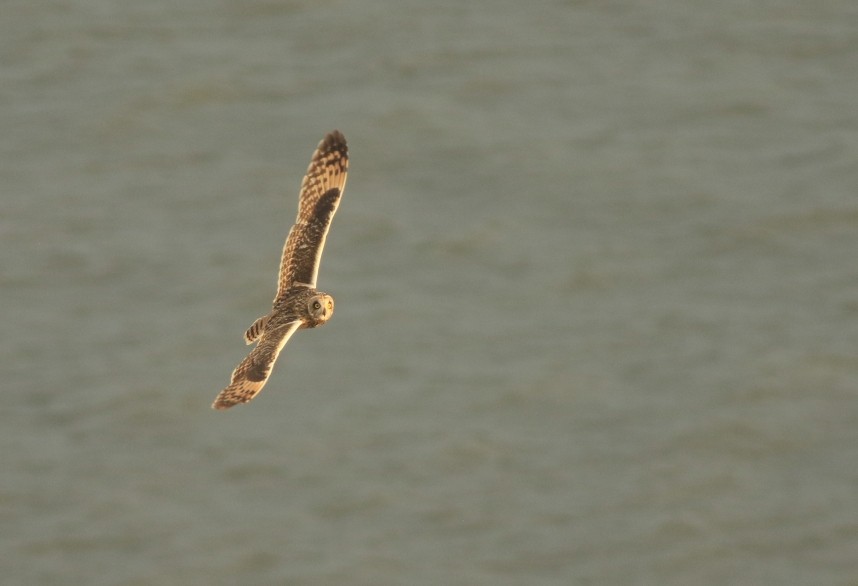
Lots of disturbance made me reconsider (think noisy kids, dogs etc coming back off the beach, on the only narrow track from which to bird - anathema to a tiring, ill, grumpy birder with minutes left on the clock), but there was enough activity up in the canopy to make me stay; although the light was indeed shocking, with everything effectively silhouetted high up in the black and grey, Goldcrests and Chiffchaffs were clearly fresh in and worthy of the last dregs of my attention span.
At which point, something more interesting appeared - high up and always at least partially obscured, but enough to sound the alarm. Craning and straining to piece it together and with the ISO on full to get any kind of plumage features (and trying to block out the screams and barks beside me), the elusive little sprite eventually revealed itself as a Red-flanked Bluetail - Bingo! A fittingly exhilarating end to a memorably wonderful day here in Filey.
Red-flanked Bluetail, high up in the canopy © Mark Pearson 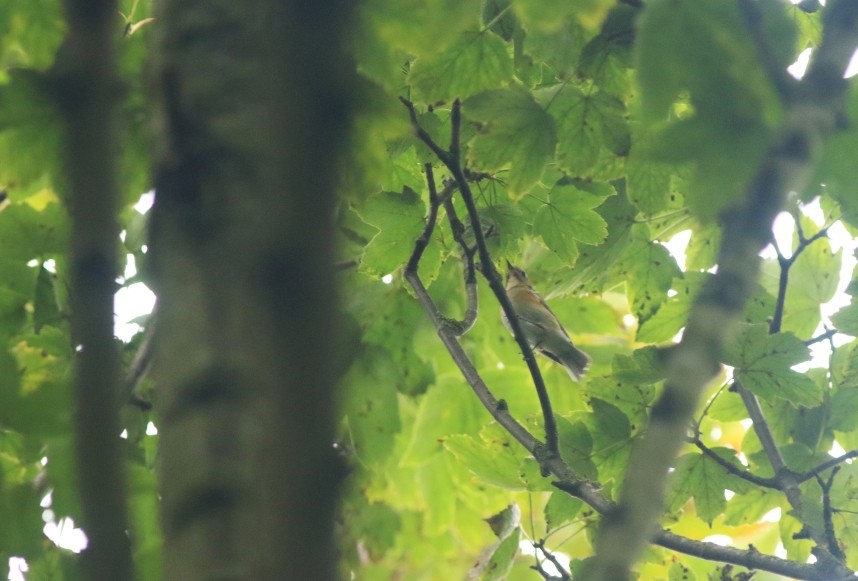
9th - 15th
Things calmed down considerably for the next week, although there was still plenty of classic October action - regular checks of the northern coastal area produced good numbers of fresh-in Robins, Goldcrests, two new Yellow-brows on 9th and a Mealy Redpoll on 11th, while passage over the sea continued with plenty of varied wildfowl, two adult Pomarine Skuas (and 40 Whoopers) on 14th, regular Long-tailed Ducks, and seven Sooty and two Manx Shearwaters on 15th.
One of, well, many Redwings at Spurn © Mark Pearson 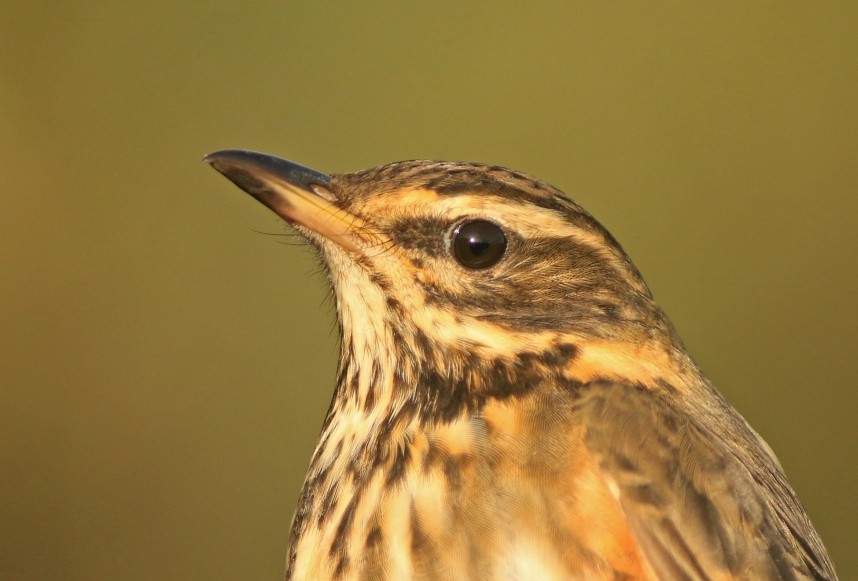
16th - 20th
By the (very) early morning of the 16th, it was time to head down the coast for five days guiding at the mighty Spurn Bird Observatory. I'm lucky to have been guiding our Yorkshire Coast Nature autumn birding days there for many years, and it's always a part of the guiding calendar I especially look forward to. Even when it's quiet birdwise, it's great to be there; but when the stars align, it's as absorbing as you might imagine - which is exactly what happened this year.
Conditions over the five days were variable, with a couple of calm days to begin with, followed by a couple of more blustery ones, and ending on an epic high, with a huge arrival on the final day; the wind direction, however, was favourable throughout, a huge blessing. Prior to that unbounded migration deluge, there was much to enjoy, with a decent flow of incoming migrants (particularly thrushes and finches, plus Goldcrests, Woodcocks, Short-eared Owls and the like), and our YCN clients were in on finding another Red-flanked Bluetail.
.... while the last day was just a constant barrage of incoming wonder. Before first light out of the Obs bathroom window I could hear a cacophony of passerine contact calls overhead, and I was outside in the pre-dawn gloom, immediately surrounded by thrushes and finches, including numerous Bramblings and several Hawfinches....
By the time the light began to fade, we'd experienced one of those uniquely east coast days of absolute migration madness, and by the end of the week, my 25 YCN clients (in teams of five each day) had experienced Spurn on top form once again. (Warm thanks to the Obs personnel and the local birding community for making us feel so welcome once again - and if you want to join me this autumn, see here).
20th - 24th
Returning to Filey, and out in car-shuddering winds on 20th for a look at the roaring sea - a juvenile Pom and 23 Little Gulls the best of it before a retreat was required - before conditions started to abate the following day (21st), when several hours from dawn in the northern coastal area produced a Little Auk south, no fewer than five Short-eared Owls (three in off, two in the Rocket Pole Field), plenty of thrushes and finches and another 12 Little Gulls.
Another session on 21st til dusk was also productive, with a ringtail Hen Harrier in off (above), another Long-tailed Duck (a good autumn for this species here), Dark-bellied Brent and Barnacle Geese (and various ducks) on the move, a new Yellow-brow in Long Lane, at least four Twite with the Carr Naze Linnet flock, and more thrushes and finches arriving. Every day was providing ...
An exhausted Siskin on the cliff side © Mark Pearson 
... and the 22nd was no different, with a few hours in the morning here at Filey surprisingly producing two Common Cranes heading south (a scarce annual migrant, and particularly rare in autumn), more wildfowl on the move, and incoming passerines including small numbers of thrushes, three Lapland and one Snow Bunting, 14 Twite, and Bramblings, Siskins and Redpolls into double figures; more passerines arrived the following day, as well as a Marsh Harrier in off and increasing numbers of inbound Skylarks, while a smart Black-throated Diver was the highlight of a quieter 24th.
Which was all well and good, but the forecasts had increasingly predicted a perfect storm was brewing - and so it came to pass, to maximum effect, on the 25th. The stars aligned perfectly for the second time in the month, and I was up on Carr Naze before dawn, just as the avian deluge began: floods of thrushes, finches and other passerines, at all heights, in often hundreds-strong, seemingly never-ending squadrons - which continued for hours.
It was one of those days that makes you shudder with awe and joy from the first moment of half-light to the last; a relentless, multi-species inbound barrage of migratory mayhem, all magnetised directly to your doorstep patch, and all with effectively no-one else around - just bird after bird after bird, flooding in from over the crashing waves.
Almost six hours straight from 0700hrs for the first session was, well, a riot; it's hard to know where to begin, but the thrushes were incredible, and the main components of the deluge - (likely very) low estimates of 11,240 Fieldfares (my highest count here by some distance), 8950 Redwings, 7138 Blackbirds and 1570 Song (and five Mistle) Thrushes provided the constant thrills, with many other species clocking up fantastic totals in such a small area:
Woodcock in the Top Scrub © Mark Pearson 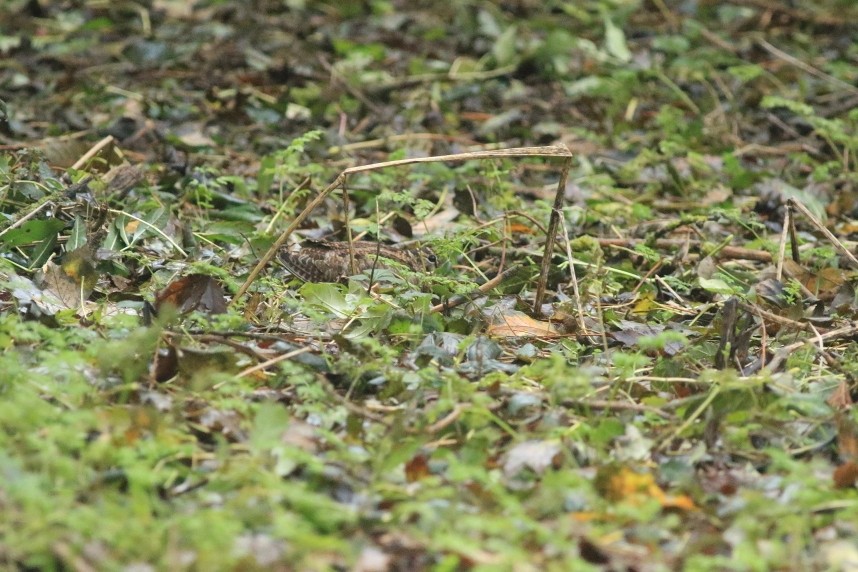
Six Waxwings (one, three and two, all in off), 86 Skylarks (all in off), 12 Blackcaps, 75 Goldcrests, three Ring Ouzels, 65 Robins, five Sparrowhawks, 31 Bramblings (mostly in off), a Yellow-brow, a Hawfinch (in off), and an incredible 35 Common (Mealy) Redpolls (24, eight and three) to name but a few. Full eBird checklist here.
And then there was the afternoon session, which kicked off with a vengeance as soon as I arrived. Birds were still flooding in off the sea, and either ditching down onto the wet, grassy plateau of Carr Naze or gunning straight for the nearest available cover on the Country Park. Within minutes, it was clear that Goldcrests were likely to be the stars of the show, with birds buzzing past my feet and tinkling calls emitting from the grass all around me.
For the next few hours, they were indeed the headline act of a stellar cast, and I had the unbridled joy of them landing on my legs and arms several times as they stepping-stoned from the cliff edge to more hospitable habitat.... by the end of the session, I'd made a conservative estimate of 310, but there were doubtless many more arriving.
Above me, birds were flowing in, and it was one of those sessions that required plenty of focus to pick out unusual calls and shapes as they gunned inland - and within the throngs of thrushes, Starlings and Skylarks, I managed to nail a Shore Lark, a Snow Bunting, a couple of Ring Ouzels, and plenty more Bramblings, Siskins and other classic late autumn passerines; on the cliffside, a juvenile Wheatear gave me the runaround, and turned out to be a very pale Northern (lightning didn't strike twice, at least not yet).
The aforementioned nearby cover was dripping with birds, and as well as Goldcrests, thrushes and Robins (at least 65 of the latter), I had the pleasure of a Firecrest, a Yellow-browed Warbler, four more Common Redpolls, eight more Woodcocks and lots of Blackcaps among other species, and the sea was busy, too - lots of wildfowl and waders on the move, and late Arctic and Common Terns passing by. What an incredible, thrilling and joyful day's birding.
Looking at the weather maps, the excitement wasn't about to stop anytime soon - indeed, if anything, the levels were likely to be ramped up even further, with a dream of an extended easterly channel having opened up from as far away as the central Asian steppe all the way to the North Sea - putting wide-eyed, butterfly-stomached east coast birders like me on red alert for something seriously special; springing out of the front door on 26th, despite the challenging wet and windy conditions, I had a very good feeling.
The usual clifftop loitering and wandering produced plenty of quality - Jack Snipe and Short-eared Owl in off, wildfowl on the move (including Barnacle and Pink-footed Geese, Whooper Swans, Pintails and Long-tailed Ducks), Woodcocks nestled into the cliffside grasses (thanks, Zeiss thermal imager!), and a trickle of passerines arriving - before a thorough, patient check through nearby cover before the weather closed in seemed like the best option.
Dark, wet conditions were indeed challenging, but the roving feeding flocks of Goldcrests and tits were too tempting to even think about bailing on, and before long I managed to dig out both Yellow-browed Warbler and Firecrest - before a loud, cheery, oddly familiar 'chuwit' stopped me dead in my tracks....
A frantic search of the dark, dripping canopy by following many clear, identical calls later, and - after one of those nerve-shredding runarounds only a potentially rare bird can give you - I'd thankfully, joyfully nailed a classic Hume's (Leaf) Warbler.
A pale, wet Wheatear, in easterlies, at the end of October © Mark Pearson 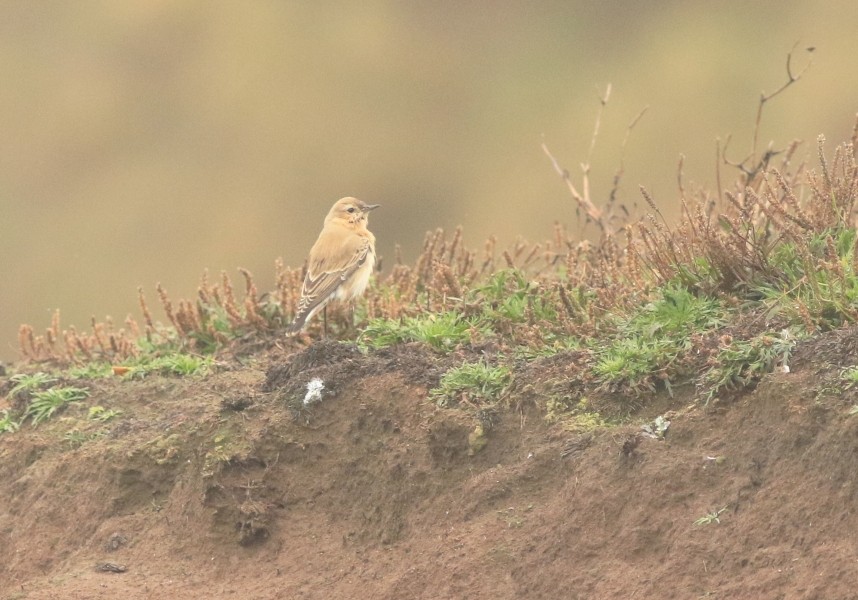
A dream find, and one that's been on my finding radar for many years; I've seen plenty in their normal range in Asia, several in Israel, a few in the UK, but finally I'd crossed paths with my own here on the patch. I'd been refreshing my knowledge (particularly calls) of potential eastern vagrants over recent evenings, and so they (including Hume's) were very much fresh in mind, and the homework paid off - as did the persistence, with conditions soon closing in and the rest of the day dominated by rain and wind.
Time for a breather, to soak up the successes of the week? Not likely... with the easterlies (and the influx) continuing, the following day was spent guiding at Flamborough as part of my regular autumn Yorkshire Coast Nature Migration Specials - what timing!
As a guide, especially when you're focusing on migration and its wonders, these are the kind of days you dream of, and we started in the lighthouse area, soaking up the spectacle - which included a vocal Hawfinch, bucketloads of thrushes including 2450 Fieldfares, Common Redpolls, lots of Bramblings, Chaffinches, Siskins, Goldcrests, and Skylarks - before a clifftop walk over to North Marsh.
Ring Ouzel © Mark Pearson 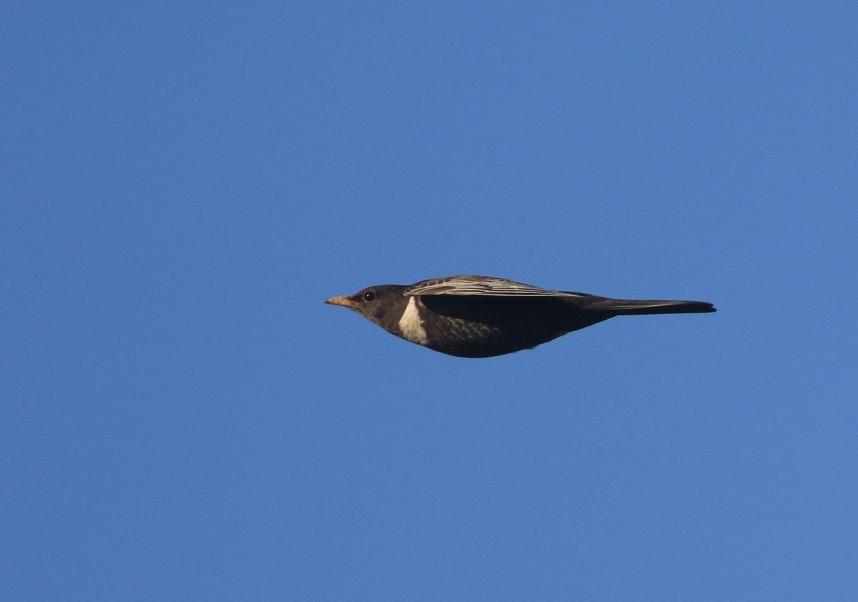
Where, happily, the recently-arrived Red-headed Bunting put on a great show, with a supporting cast of Marsh Harrier, Twite, Short-eared Owls, and Goldcrests scattered along the grassy paths. Back to the lighthouse area for the remainder of the afternoon, and birds continued to arrive - lots of commoner species, plus great views of Pallas's Warbler, and just as we were walking back to the car, a Dusky Warbler appeared - at point blank range! - on an umbellifer right in front of us on the clifftop, clearly having just touched down. Absolute magic.
Continental Song Thrush on the clifftop © Mark Pearson 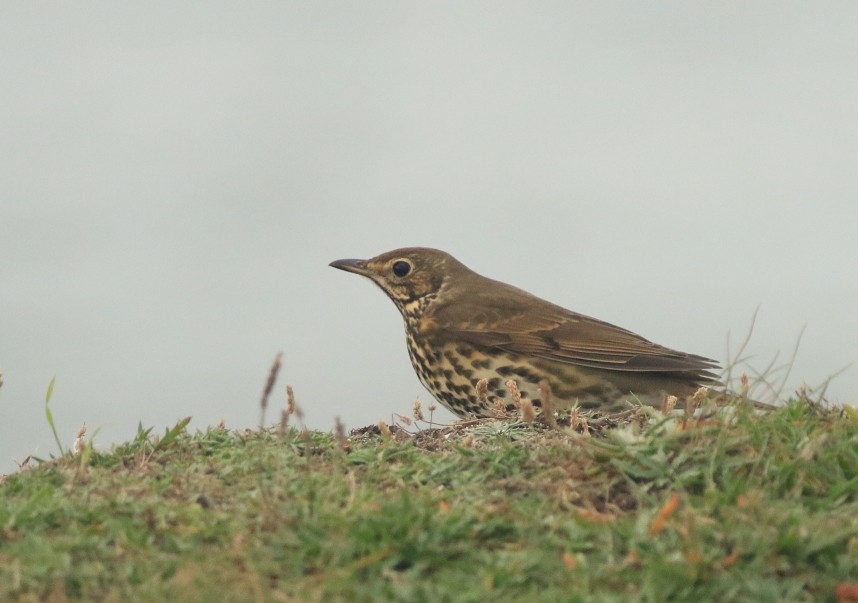
Quite a few days, and indeed, quite a month - epic falls, huge movements (by day and night), many memorable moments and days, lots of scarcities, and a fistful of special rarities to sprinkle a little stardust on proceedings (not that it was needed....).
YCN Birding and Wildlife Guide
To book Mark as your bespoke guide here or at other locations, just call Richard Baines 07747753260 or email richard.baines@yorkshirecoastnature.co.uk



 Back to Blog
Back to Blog
